The Northern Cardinal (Cardinalis cardinalis) is a striking bird known for its vibrant red plumage and distinctive crest. While there are no birds that perfectly mimic the Cardinal’s appearance, there are several species that share similar features or colorations.
The top 10 birds that are similar to cardinals
- Pyrrhuloxia
- Tufted Titmouse
- Scarlet Tanager
- Vermilion Flycatcher
- Summer Tanager
- Phainopepla
- Red Crossbill
- Cedar Waxwing
- Pine Grosbeak
- Red-Crested Cardinal
Key Takeaways:
- While no birds perfectly mimic the Cardinal’s appearance, several species share similar features or colorations.
- The Summer Tanager exhibits a reddish color similar to the Cardinal, although it lacks the crest.
- The Scarlet Tanager displays a brilliant red plumage like the Cardinal but lacks the crest as well.
- The Vermilion Flycatcher shares a vibrant red color, but has a smaller size and different body shape compared to the Cardinal.
- Other birds such as the Red-headed Woodpecker, Flame-colored Tanager, Red-crested Cardinal, Hepatic Tanager, Western Tanager, Red-breasted Nuthatch, Red-capped Cardinal, and Rose-breasted Grosbeak may also resemble Cardinals to some extent.
Pyrrhuloxia

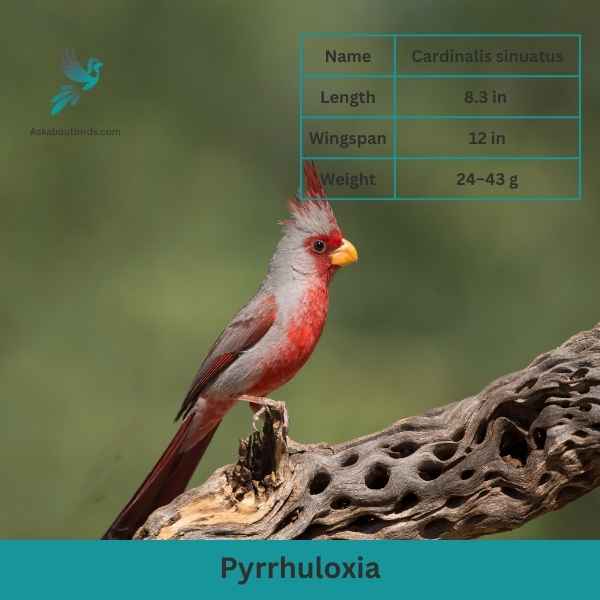
| Feature | Measurement |
|---|---|
| Scientific Name | Cardinalis sinuatus |
| Length | 8.3 in |
| Wingspan | 12 in |
| Weight | 24–43 g |
The Pyrrhuloxia, also known as the Desert Cardinal, is a medium-sized songbird native to the southwestern United States and northern Mexico. It is closely related to the Northern Cardinal but possesses its own unique characteristics. The Pyrrhuloxia is named after its vibrant red crest and mask-like face markings, similar to that of the Northern Cardinal. However, its overall coloration is more muted, with a grayish body and reddish wings and tail.
Pyrrhuloxias are known for their distinct vocalizations, which include a variety of songs and calls. Males often sing from elevated perches to defend their territories and attract mates. They also engage in aggressive displays to establish dominance.
Cedar Waxwing
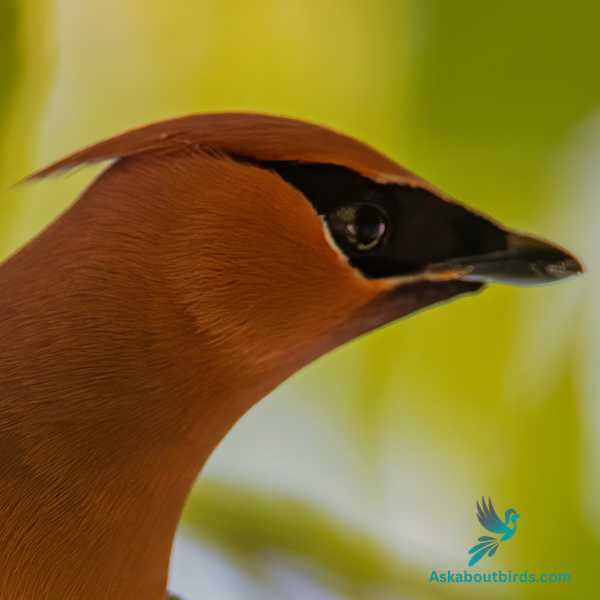
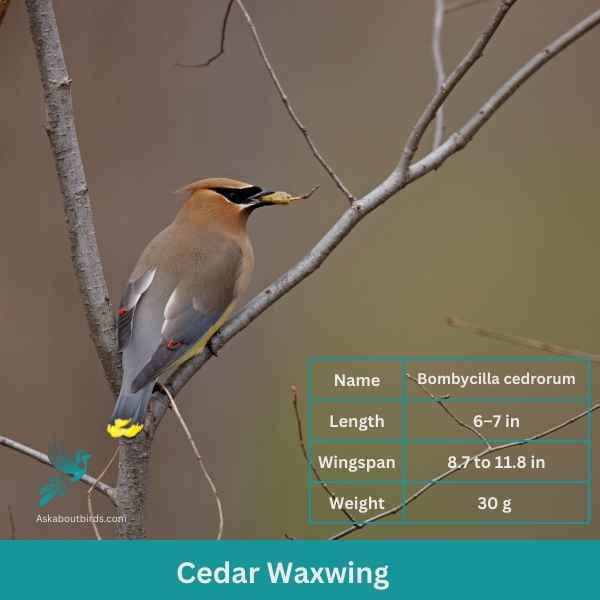
| Feature | Measurement |
|---|---|
| Scientific Name | Bombycilla cedrorum |
| Length | 6 – 7 in |
| Wingspan | 8,7- 11.8 in |
| Weight | 30g |
The Cedar Waxwing is a charming and sociable songbird found in North America. It is known for its sleek and silky plumage, featuring a blend of gray, brownish grey, and yellow tones, with their tails having a bright yellow tip. These birds have a distinctive black mask across their eyes and a small crest on their head, adding to their elegant appearance.
Cedar Waxwings are primarily frugivorous, feeding on a variety of fruits such as berries and soft fleshy fruits. They are often seen in flocks, perched in trees or flying together in coordinated formations. These birds have specialized adaptations, including a unique hooked bill, which allows them to pluck fruits from trees and eat them while in flight.
Red Crossbill
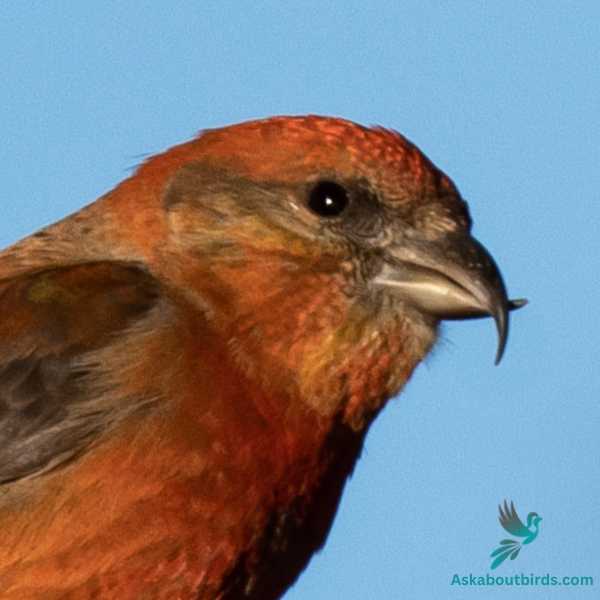

| Feature | Measurement |
|---|---|
| Scientific Name | Loxia curvirostra |
| Length | 20 cm |
| Wingspan | 27–29 cm |
| Weight | 40-53 g |
The Red Crossbill is a peculiar bird species, celebrated for its unique beak structure and vibrant coloration.
Appearance: Red Crossbills are named for their distinctive crossed mandibles, which are adapted to extracting seeds from conifer cones. Male Red Crossbills are usually bright red or orange, while females and juveniles are greenish-yellow. All have dark wings and notched tails.
Diet: The diet of the Red Crossbill is primarily composed of conifer seeds, their unique beak allowing them to access these seeds with ease. This diet includes seeds from pine, spruce, and other types of coniferous trees. They are also known to consume some insects.
Reproduction: Red Crossbills are known for their flexible breeding season, which can occur any time of the year when there is an abundance of food. They typically nest in conifers, where the female lays a clutch of 3 to 4 eggs.
Tufted Titmouse

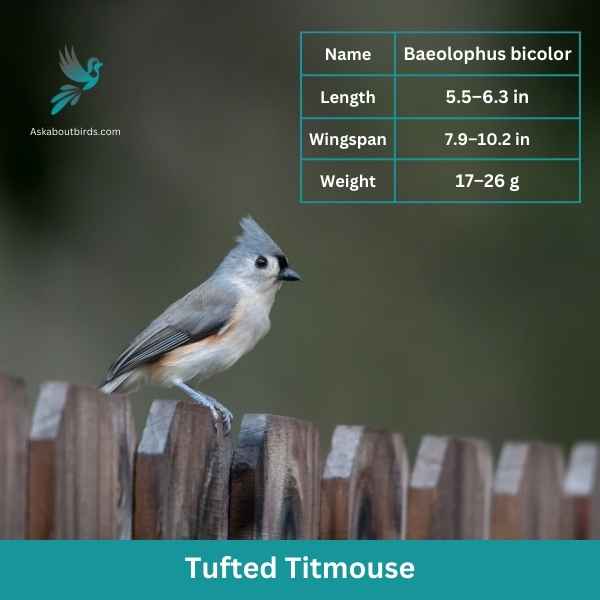
| Feature | Measurement |
|---|---|
| Scientific Name | Baeolophus bicolor |
| Length | 5.5–6.3 in |
| Wingspan | 7.9–10.2 in |
| Weight | 17–26 g |
The Tufted Titmouse, a small songbird native to eastern North America, is instantly recognizable with its gray plumage, prominent black tufted crest, and lively demeanor. These birds are highly social and can often be spotted in small family groups or mixed-species flocks as they forage through woodlands. With their acrobatic skills, they adeptly search for insects, seeds, and berries, using their stout bills to crack open seeds and extract food.
Known for their vocal nature, Tufted Titmice produce a variety of calls and songs. Their most common call is a whistled “peter-peter-peter” sound, serving as a means of communication within their flock. Their melodious tunes add a cheerful soundtrack to the forest environment. The Tufted Titmouse is a delightful presence in the natural world, captivating observers with its charming appearance, lively foraging behavior, and harmonious melodies.
Scarlet Tanager


| Feature | Measurement |
|---|---|
| Scientific Name | Piranga olivacea |
| Length | 6.3 to 7.5 in |
| Wingspan | 9.8 to 11.8 in |
| Weight | 23.5 to 38 g |
The Scarlet Tanager is a strikingly colorful bird known for its brilliant plumage and distinctive song.
Appearance: Male Scarlet Tanagers are notable for their vibrant scarlet bodies contrasted with black wings and tail, making them one of the most intensely colored birds. Females and juveniles, on the other hand, have a subdued olive-yellow body color with darker wings and tail.
Diet: The diet of the Scarlet Tanager is largely made up of insects, including beetles, cicadas, aphids, and others. They are adept flycatchers, seizing insects in mid-air or picking them off foliage. They also consume fruits and berries, especially during migration and in their winter habitats.
Reproduction: The female Scarlet Tanager builds a cup-shaped nest using twigs, rootlets, and grass, typically well-hidden in the dense foliage of trees. She lays 3 to 5 eggs and incubates them for about two weeks.
Vermilion Flycatcher
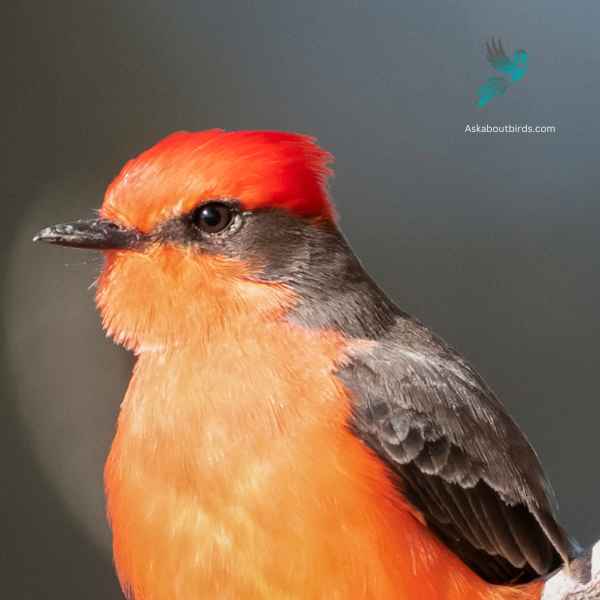

| Feature | Measurement |
|---|---|
| Scientific Name | Pyrocephalus obscurus |
| Length | 5.1–5.5 in |
| Wingspan | 9.4 to 9.8 in |
| Weight | 11 to 14 g |
The Vermilion Flycatcher is a small and colorful bird native to the Americas. The male Vermilion Flycatcher is a striking sight, displaying a vibrant red plumage on its head, breast, and underparts, contrasting with its brown wings and black tail below. Females, on the other hand, have more muted colors, featuring a pale yellowish belly and grayish-brown upperparts.
Vermilion Flycatchers are known for their lively and acrobatic flight displays, which they perform during courtship or to defend their territories. They often sing a series of soft, whistled notes while engaged in these aerial displays. They construct cup-shaped nests, usually in shrubs or low trees, where females lay their eggs and raise their young.
Pine Grosbeak

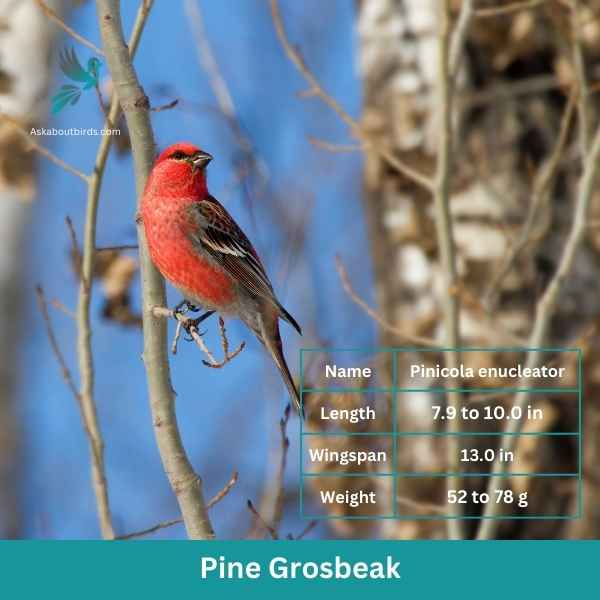
| Feature | Measurement |
|---|---|
| Scientific Name | Pinicola enucleator |
| Length | 7.9 to 10.0 in |
| Wingspan | 13.0 in |
| Weight | 52 to 78 g |
The Pine Grosbeak is a striking bird native to the northern regions of North America, often found in coniferous forests. Both males and females have a plump and robust body with a large beak adapted for eating seeds. The male Pine Grosbeak displays a vibrant reddish-pink plumage, while the female has a more subdued grayish-brown coloration.
These birds are typically seen in small flocks, foraging for food in trees and on the ground. They have a preference for seeds, particularly those from various conifer species. The Pine Grosbeak uses its strong bill to crack open the cones of tall trees and extract the seeds, but they also consume berries and small fruits when available.
Summer Tanager


| Feature | Measurement |
|---|---|
| Scientific Name | Piranga rubra |
| Length | 6.7 in |
| Wingspan | 28 to 30 cm |
| Weight | 29 g |
The Summer Tanager is a medium-sized songbird admired for its radiant plumage and melodious song.
Appearance: Male Summer Tanagers are an impressive bright red, while females and juveniles present a softer, yellow-orange color. Both genders have a large, slightly hooked bill and relatively short tail.
Diet: Summer Tanagers primarily feed on insects, including bees and wasps, which they catch in flight or pick off vegetation. They are also known to eat fruits and berries, making them helpful in controlling pest populations and seed dispersal.
Reproduction: The female Summer Tanager builds a loose, shallow cup-shaped nest out of twigs and grass, usually hidden in the foliage of trees. The female typically lays 3-5 eggs, which she will incubate for about two weeks.
Red-Crested Cardinal
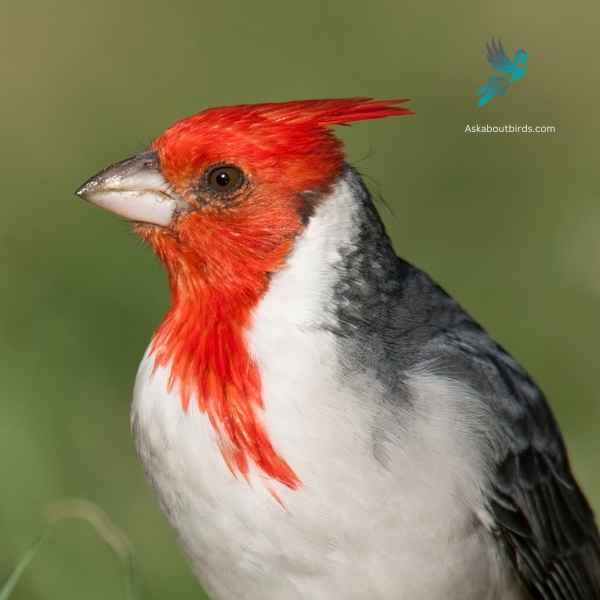
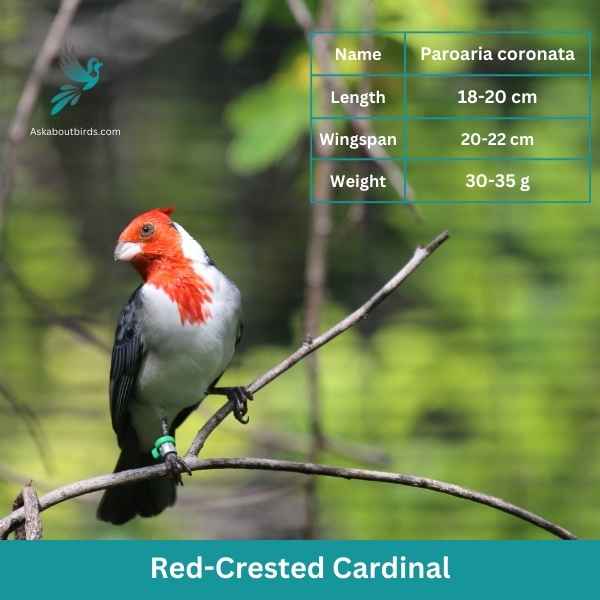
| Feature | Measurement |
|---|---|
| Scientific Name | Paroaria coronata |
| Length | 18-20 cm |
| Wingspan | 20-22 cm |
| Weight | 30-35 g |
The Red-Crested Cardinal is a visually striking bird native to South America, particularly found in countries like Brazil and Argentina. It is named for its vibrant red crest, which stands tall atop its head, contrasting with its grayish body and wings. Both males and females share this distinctive feature, with males having more pronounced red coloration.
These cardinals are typically found in open habitats such as grasslands, savannas, and gardens. They have adapted well to human-altered landscapes. Red-Crested Cardinals are omnivorous, feeding on a diverse diet that includes seeds, fruits, insects, and even small vertebrates. They use their powerful beaks to crack open seeds and capture prey.
Phainopepla


| Feature | Measurement |
|---|---|
| Scientific Name | Phainopepla nitens |
| Length | 6.3 – 7.9 in |
| Wingspan | 10 – 12 in |
| Weight | 0.6 -1 oz |
The Phainopepla is a unique songbird known for its striking appearance and its association with desert habitats, particularly those with mistletoe plants.
Appearance: The male Phainopepla has a glossy black plumage with a distinct crest, while the female is gray with a slight crest. Both genders have deep red eyes, adding to their characteristic look.
Diet: Phainopeplas predominantly feed on mistletoe berries. However, they also consume insects, especially during the breeding season, catching them mid-air or picking them off vegetation.
Reproduction: Phainopeplas nest in trees or shrubs. The female lays a clutch of 2 to 4 pale blue eggs. Intriguingly, these birds can breed twice in a year: once in the desert during spring and again in coastal areas during summer.
15 Fun Facts About Cardinals
- Bright Red Plumage: Male cardinals are known for their striking bright red feathers. This vibrant coloration helps them attract mates and defend their territory against other males.
- Female Cardinals: While male cardinals steal the spotlight with their red plumage, female cardinals have a more subtle beauty with reddish-brown feathers and a crest.
- Northern Cardinal: The northern cardinal (Cardinalis cardinalis) is the most recognized and well-known species of cardinal. It is also the official state bird of seven U.S. states.
- Wide Range: Cardinals are native to North and Central America, with their range extending from southern Canada to northern Mexico.
- Year-Round Residents: Unlike many migratory birds, cardinals are non-migratory and can be found in their range throughout the year.
- Distinctive Song: Cardinals are known for their clear, whistling song that sounds like “cheer, cheer, cheer” or “birdie, birdie, birdie.” Males often sing to establish territory and attract mates.
- Monogamous Birds: Cardinals are monogamous, meaning they mate with only one partner for life. They form strong pair bonds and often stay together year-round.
- Lifespan: Cardinals have an average lifespan of about 3 years in the wild. However, some individuals have been known to live up to 15 years.
- Diet: Cardinals are primarily seed-eaters, but they also consume insects, fruits, and berries. They are often attracted to bird feeders that offer sunflower seeds.
- Territory Defense: Male cardinals are fiercely territorial and will vigorously defend their nesting area and food sources against intruders, including their own reflection in windows or mirrors.
- Cardinals and Cardinals: The name “cardinal” is derived from the bright red robes worn by Catholic cardinals, which resemble the bird’s plumage. Interestingly, the term “cardinal” is also used to refer to various bird species from different families around the world.
- Year-Round Nesting: Cardinals are known to be early breeders, with nesting occurring as early as February. They build cup-shaped nests in dense shrubs or trees, often using twigs, grass, and leaves.
- Egg Color: Female cardinals lay 2-5 eggs per clutch, and their eggs have a pale greenish or bluish tint with brown speckles. The coloration helps camouflage the eggs within the nest.
- State Birds: As mentioned earlier, the northern cardinal is the state bird of seven U.S. states: Illinois, Indiana, Kentucky, North Carolina, Ohio, Virginia, and West Virginia.
- Symbolism: Cardinals are often associated with positive symbolism and are believed to represent hope, love, and good luck in various cultures and traditions.
FAQs on Birds that look like cardinals
What bird looks like a cardinal?
Birds that look like Cardinals often share their distinctive bright red plumage, body shape, and other unique features. For instance, the male Scarlet Tanager, one of these bird species, boasts a vibrant red body and black wings, mirroring the contrast found in male Cardinals. Another bird, the Summer Tanager, common in South America, also possesses a bright red coloration similar to male Cardinals, however, it doesn’t have the crested head typical of Cardinals.
What red birds look similar to cardinals?
When considering red birds similar to Cardinals, both the Scarlet Tanager and Vermilion Flycatcher stand out. Known for their bright red coloration, these two birds also offer striking resemblances to male Cardinals. The Scarlet Tanager, a Northern Cardinal counterpart, features a vibrant red body with black wings. On the other hand, the Vermilion Flycatcher, a bird species native to Southwestern United States and Central America, exhibits a bright red head and a pale brown body, mirroring the color distribution of the male Cardinal.
What red bird looks like a cardinal but no crest?
The Summer Tanager, found across Central and South America, is a red bird that bears a resemblance to a Cardinal but lacks the crest. This bird has a bright red plumage akin to the male and female Cardinal above, a similar body shape, but it can be differentiated by its uniformly colored body and absence of a crest.
What is a black and brown bird that looks like a cardinal?
Resembling the Northern Cardinal in body shape, the Tufted Titmouse offers a likeness despite its different color palette. While not black and brown, it presents a pale brown body with gray wings and a black mask around its eyes, akin to thin black mask on the Cardinal’s face. Native to North America, this bird is often seen at bird feeders, similar to Cardinals.
What are some small red birds that look like cardinals?
Among tiny birds that resemble Cardinals, the Red Crossbill and the House Finch stand out. The Red Crossbill, known for its red body and unique crossed orange beak, carries some similarities with gray beak of the male Northern Cardinals. The House Finch, while showing different shades of red, mirrors the bright red coloration of the Cardinals and is often spotted in the same habitats as Cardinals. Other birds include the purple finch, desert cardinals and red billed firefinch.
What is the difference in looks between a male Northern Cardinal and a female
The key difference between male and female Northern Cardinals lies in their plumage. Male Cardinals are known for their bright red plumage, black mask around the eyes, and a bright orange beak. On the contrary, female Cardinals display a more subdued coloration with a buff-brown body, red wings, and tail feathers, while maintaining the distinct orange beak and black mask, albeit in a less bold version.




